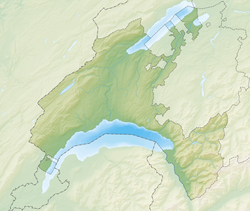Top Qs
Timeline
Chat
Perspective
Synagogue of Lausanne
Synagogue in Lausanne, Switzerland From Wikipedia, the free encyclopedia
Remove ads
The Synagogue of Lausanne (French: Synagogue de Lausanne) is a Jewish congregation and synagogue, located at 1 Avenue de Florimont in Lausanne, Vaud, Switzerland. The building is a Cultural Property of National Significance.
Remove ads
History
Summarize
Perspective
In the early 20th century, the Jewish community gathered in the Jean-Jacques Mercier building on Rue du Grand-Chêne in Lausanne. The community grew rapidly and wanted to have a larger place of worship.[2]
Upon the death of French merchant Daniel Iffla ("Osiris"), the City Council of Lausanne received a bequest of 50,000 francs. This donation aimed at building a new synagogue which had to be inspired from the Buffault Synagogue in Paris.[3]
The synagogue was built in 1909–1910[2] thanks to the financial support of the local Ashkenazi community.[4] The City of Lausanne also allocated 300,000 francs for the construction.[5] The building was designed by Vaudois architects Charles Bonjour, Adrien van Dorsser and Oscar Oulevey and inaugurated on November 7, 1910.[6]
The cost of land acquisition and construction totalled 280,000 francs, including 48,000 francs for the structural system and 28,000 francs for the decoration and the furniture.[2]
After WWII, the community grew and integrated Sepharadi Jews, which requested unity in the rites and the use of the synagogue.[7]
In 2010, Israelite Community of Lausanne and the Canton of Vaud (CILV) celebrated the centenary of the synagogue and organised events aimed at "forging bonds with Lausanne and Vaud people",[8] including an exhibition about the history of the synagogue.[9]
The synagogue is now listed among the Cultural Property of National Significance.[10] It is used for Shabbat celebrations, but usually the daily service takes place in a smaller underground room.[6] In 1995, a liturgical music concert took place at the synagogue.[11]
Remove ads
Architecture
The Romanesque-Byzantine[2] synagogue has a long nave that can be reached from the vestibule. Three sides of the nave are bordered by galleries with 160 seats for women. The stalls are dedicated to men only.[2] The Almemohr has a tabernacle with the Torah scrolls, as well as the seat used by the rabbi. The paintings were made by Otto Alfred Briffod and the stained-glass windows were manufactured by the workshop Guignard & Schmid.[2] There is an adjacent sacristy. The underground floor has several locales.
Remove ads
See also
References
Bibliography
External links
Wikiwand - on
Seamless Wikipedia browsing. On steroids.
Remove ads


